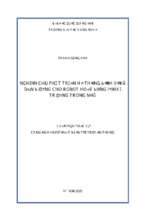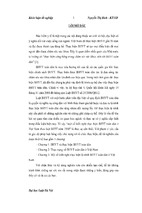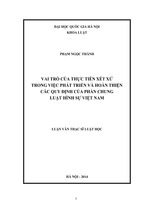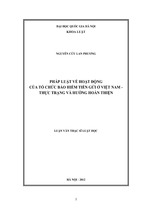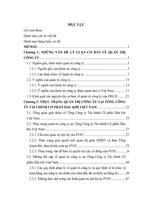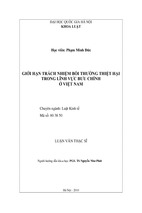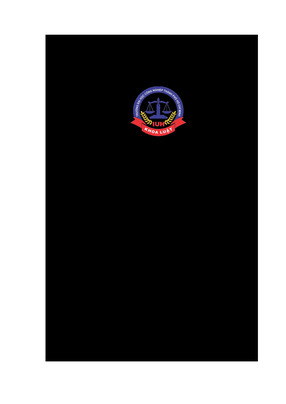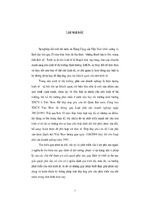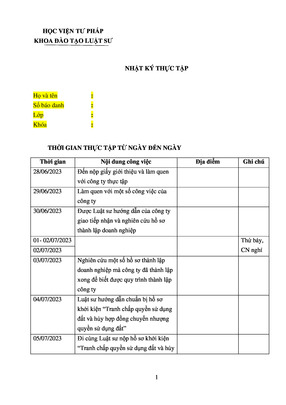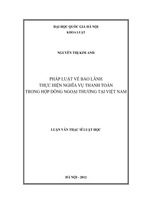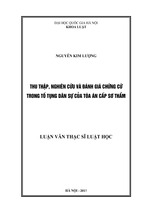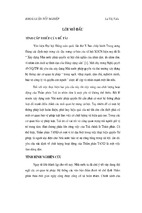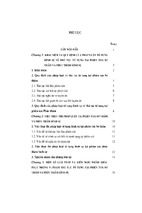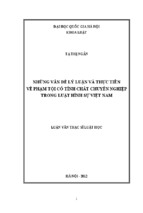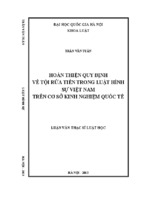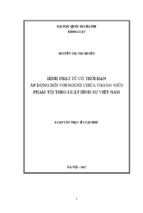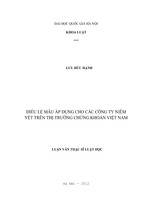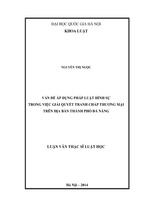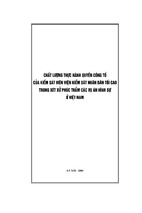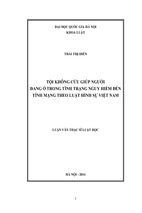MINISTRY OF EDUCATION AND TRAINING
HO CHI MINH CITY UNIVERSITY OF LAW
GRADUATION THESIS
B.A. DEGREE IN ENGLISH
Major: Legal English
THE DEVELOPMENT OF ENGLISH REFLECTING IN ENGLISH
LITERATURE WORKS AND LEGAL DOCUMENTS
Supervisor
: PHAM THI THUY DUNG, MA
Student
: TRAN QUYNH HOA
Student ID
: 1852202010025
Class
: 100 – LE43A
Ho Chi Minh City, 2022
ACKNOWLEDGEMENT
I consider it a great honour to be one of the students who are qualified to complete the
graduation thesis, as I have always wanted to have a thorough study on the topic that
I’m interested in. The process of completing the graduation thesis is a priceless journey.
It is definitely not an enjoyable and pleasant time. Indeed, I was constantly nervous and
self-conscious all the time. However, I felt so lucky when I was surrounded by
supportive friends and family who supported me with unfailing encouragement.
Therefore, I must devote this very first page to thanking these dearest people.
First and foremost, I would like to express my genuine thankfulness to my supervisor,
Mrs. Pham Thi Thuy Dung, for her invaluable advice and comforting words during the
research process. I was so nervous and unconfident about my findings and even
sometimes lost in such a large research field, but she always found ways to help me out
with her sophisticated knowledge. I am so thankful for her guidance and patience with
me during this journey so that the outcome came out successfully.
Secondly, I am grateful for all the lecturers I have had the opportunity to study with
during 4 years of university. They have delivered a great deal of invaluable knowledge,
which generated the initial idea for this study and then became the fundamental
knowledge to bring out such a detailed work.
Moreover, I am especially thankful to have such a supportive family with my beloved
Dad and Mom, who always have faith in me and support me unconditionally.
Additionally, I owe special thanks to my friends Sang and Mei who have always stayed
by my side, supported and encouraged me from afar. Furthermore, I would like to give
my warm thanks to Cher for her comforting words and Thao Linh for her company
during this challenging process.
Finally, I would like to declare my gratitude towards other beloved ones that I cannot
name in full. Without their constant support and inspiration, I would not be able to
accomplish this precious experience.
i
LIST OF ABBREVIATION
OE
Old English
ME
Middle English
e.ME
Early Modern English
AE
American English
BE
British English
a
adjective
n
noun
v
verb
ii
LIST OF TABLES
Table 1: Conceptual framework of the study ................................................................10
Table 2: Old English words that vanished .....................................................................18
Table 3: Old English words that survived .....................................................................20
Table 4: List of compounds in Beowulf .........................................................................21
Table 5: Functions of cases in grammatical inflections ................................................23
Table 6: Native words displaced by French vocabulary ...............................................27
Table 7: Old English vocabulary came from different foreign sources ........................29
Table 8: Origins of Middle English vocabulary ............................................................37
Table 9: Comparison of personal pronouns in OE and e.ME .......................................43
Table 10: Differences between British and American English vocabulary ..................49
Table 11: AE words that emerged into BE vocabulary during Modern English period
.......................................................................................................................................52
Table 12: English borrowing words from other countries ............................................53
Table 13: List of archaic English, Latin terms and phrases in legal instruments of the
International Law Handbook ........................................................................................61
Table 14: Summary of the development of English language and legal English language
.......................................................................................................................................65
iii
TABLE OF CONTENTS
ACKNOWLEDGEMENT ............................................................................................... i
LIST OF ABBREVIATION ........................................................................................... ii
LIST OF TABLES......................................................................................................... iii
TABLE OF CONTENTS .............................................................................................. iv
CHAPTER 1: INTRODUCTION ....................................................................................1
1.1 Necessity of the study ............................................................................................1
1.2 Objectives of research ............................................................................................2
1.3 Research questions .................................................................................................2
1.4 Scope of the study ..................................................................................................3
1.5 Methodology ..........................................................................................................3
1.6 Structure of research ..............................................................................................3
CHAPTER 2: LITERATURE REVIEW.........................................................................5
2.1 Definition of key terms and related literature ........................................................5
2.1.1 English language in general and English literature .......................................5
2.1.2 Legal language and legal documents ..............................................................6
2.2 Previous studies ......................................................................................................7
2.3. Conceptual framework ..........................................................................................9
CHAPTER 3: METHODOLOGY .................................................................................12
3.1 Research questions ...............................................................................................12
3.2 Context and design of the study ...........................................................................12
3.3 Research instruments ...........................................................................................12
3.4 Analysis procedure ...............................................................................................13
CHAPTER 4: RESULTS AND DISCUSSION ............................................................15
4.1 Findings and discussion of results .......................................................................15
4.1.1. Historical background of general English language and its corresponding
characteristics .........................................................................................................15
4.1.2. Historical background of legal English language and its corresponding
characteristics .........................................................................................................56
4.1.3 The implication of acknowledgement of English origin changes on practical
English learning process of linguistics students .....................................................64
iv
4.2 Summary ..............................................................................................................65
CHAPTER 5: CONCLUSION ......................................................................................68
5.1 Conclusion ............................................................................................................68
5.2 Limitations of the study .......................................................................................68
5.3 Recommendations for further study .....................................................................69
REFERENCES ..............................................................................................................70
APPENDICES ................................................................................................................. i
APPENDIX I – Geoffrey Chaucer’s Merciless Beauty ............................................... i
APPENDIX II – Shakespeare’s Macbeth ................................................................... ii
APPENDIX III – John Donne’s The Sun Rising........................................................ iii
APPENDIX IV – Robert Burns’ A red, red rose ....................................................... iv
APPENDIX V – Charles Dickens’ Oliver Twist (Chapter 31: Involves a critical
position) ........................................................................................................................v
APPENDIX VI – Magna Carta 1215 – English version of Lillian Goldman Law
Library, Yale Law School (2008) .............................................................................. vi
APPENDIX VII – Article 48 of the Statute of the International Court of Justice
1945 ........................................................................................................................... vii
v
CHAPTER 1: INTRODUCTION
1.1 Necessity of the study
English has proved satisfactory to all the facets of a lingua franca since a large number
of countries, including the world’s largest economies such as the United States, have
officially confirmed English as their mother tongue, not to mention that this language
has also become the standard language for international commercial and communication
for decades. Besides, when it comes to global integration, the law serves a key role in
maintaining world order, leading to the urgent need to learn the language of the law –
legal English.
The rapid growth of English, and especially legal English, has resulted in the growing
demand for a large amount of learning materials which digs into this language to provide
its learners with helpful guidance during the learning process. Specifically, legal English
has long been a sophisticated field, which causes many troubles for the students who are
interested in this very complicated field. During the learning process of legal English,
even the learners who have a solid background on the English language might still
encounter several difficulties. For example, it can be seen easily that the implications of
the words in legal English totally do not depend on the common senses. Instead, to
thoroughly know the use of legal terms in legal documents, the learners must have a
great understanding of the archaic words, not only in its recent senses but also in the
meanings from the original words dated a long while ago.
Nevertheless, most of the recent English learners are ignorant of the past of the language
they are learning. This is not troublesome to those who only need a language for daily
communication or for dealing with modern commercial transactions, but it creates a
significant problem for people with an interest in linguistics, particularly, students who
have their majors in linguistic fields. According to the perspective of a Legal English
student, there is a severe shortage found in studying materials introducing the history of
the English language and its language of law. Thus, it is an urgency to contribute to the
compilation of materials with quality research that can give linguistic students a better
understanding and provide those who are in need of an interesting approach to the
English language in general and Legal English in particular.
1
There are plenty of approaches to the development of a language, however, one of the
most interesting and direct ways to get to know a language is through its literature, in
which the language is presented in its most surreal manner. Additionally, the process of
collecting illustrative examples by reading literary works then concluding the
similarities as well as differences of the topic will be more inspiring and motivated than
accessing the history of language by other academic approaches. By this way, the
learning process would be much friendlier and easier for students who have not had a
solid base in the linguistics field.
Understanding the necessity of this problem, this thesis will conduct an intensive
research on the English language development based on its legal background during
each period, and bring out a great reference which helps those who are struggling and
who have great enthusiasm in the English language and its special subset – legal English.
1.2 Objectives of research
According to the previous reasons, this thesis includes several purposes.
First of all, this research will provide a compendious history of the English language by
the historical background of each period of development. Apparently, this will include
the changes in the use of the English language, specifically in its lexicon and
grammatical aspects.
In the second place, this thesis will conclude a brief evaluation on the characteristics of
legal English with the reference made in the historical events that interfered its
development, which will all be clarified by some examples extracted from English legal
documents over different periods.
Thus, hopefully this essay will become an informative and useful source for other
linguistic students and even those who are non-professional but having great interests in
linguistics while creating a different and interesting approach to the language they are
studying to have general knowledge of the development process of English language.
1.3 Research questions
There are two expectations which should be answered after finishing this essay. The first
question is “How did English originate and then change throughout the history reflecting
in English literature works and legal documents?”. And then the research will help
address the question “How does this kind of acknowledgement benefit practical
2
language learning process of linguistic students?”. Depending on these research
questions, the final findings and results of this thesis will be closely attached to the aims
of the study, which is to present a short history of the English language and legal English
referencing in literature and legal texts written in this language.
1.4 Scope of the study
There is a diversity of research carried out on the linguistic fields, however, this thesis
will focus on two main categories: one of that is the English language used in the English
literature works, and the other is the legalese employed in various legal documents
written in English language.
1.5 Methodology
Several research methods were used during the writing process to convey persuasive
information about the topic. Firstly, the library research will be utilised to examine
relevant papers and research to establish their utility, dependability, and authority in
relation to the theme of English history. Secondly, a comparative method will be applied
after thoroughly researching past studies and articles, comparing the findings to
corresponding literature works and legal documents to understand how the English
language has changed and how beneficial those changes have been. In addition to the
preceding methods, the historical method will be used to depict various historical
components in literary works and legal records of England.
The combination of the aforementioned methodology in a reasonable and fluent manner
will provide readers of this study with a comprehensive view of the history of English
language formation based on the correlation between the development of the language
used in literary works and legal documents through each historical period.
1.6 Structure of research
This thesis consists of 5 chapters. Chapter 1: Introduction presents general background
of the study such as the necessity, the objectives of the study, the research questions to
the study and its methodology. The second chapter is Chapter 2: Literature Review,
which provides a quick look at previous relevant studies as well as introducing the
conceptual framework for this study. Then, the study’s methodology is discussed in
Chapter 3: Methodology, which also gives readers a notion of the design and context of
the study as well as the research instruments. The most important part of the study lies
3
in Chapter 4: Results and Discussion, which answers the research questions by findings
throughout the researching process. Chapter 5: Conclusion will finish this thesis by
giving a summary of the work carried out during the research, and propose some viable
suggestions for further research, which may improve the limitations encountered when
conducting this study.
4
CHAPTER 2: LITERATURE REVIEW
Apparently, the terms of English and specifically legal English are getting more and
more familiar for both native and non-native learners. Therefore, they should be
introduced properly in this paper for better comprehension. In addition, there are two
more notions that are worth mentioning in this essay, which are English literature and
legal documents, since the English literary works and legal records serve as means to
demonstrate the development process of English in general and legal English in
particular.
2.1 Definition of key terms and related literature
2.1.1 English language in general and English literature
For decades, English has been the global language. Although it is evasive and probably
not instructive to characterise such a complex and sophisticated product of a long-term
process of linguistic changes and variety in the very short word “English”, linguists also
find various approaches to explain this term, either by geographical approach or
technical approach.
To the extent of geographical interpretation, Tim William Machan (Machan, 2013, p.
14) has once defined it by the geographic location of the language: “Equally limited as
a determination of what is and is not English would be speakers’ geographic location, a
criterion present since the Anglo-Saxon days of the Venerable Bede”. Later, in their
book about this language, Albert C. Baugh and Thomas Cable (Baugh & Cable, 2005,
p. 10) indicated that: “English presents a somewhat familiar appearance to anyone who
speaks either a Germanic or a Romance language”.
Meanwhile, other academics tend to use a more technical definition of the term “English
language”. For instance, Rindal (Rindal, 2014, p. 1) believes that English language is
“the codification of a language in dictionaries and grammars”. The Oxford Learner's
Dictionary offers a more concise concept of it as “the language, originally of England,
now spoken in many other nations and used as a language of international
communication throughout the world”. All in all, it can be seen clearly that the concept
of English is classified by its origin, which can be called a West Germanic language of
the Indo-European language family, and represented by the specific sets of grammar
5
rules governing the use of this language as well as the great number of words developed
and recorded throughout the development process.
Next, when it comes to language study, literature is one of indispensable terms that
needs discussion due to the intimate association of the two concepts. According to
Oxford Learner’s Dictionary, literature refers to pieces of writing that are valued as
works of art, especially novels, plays, and poems (in contrast to technical books and
newspapers, magazines, etc.). There are many scholars who had explained this term in
different ways. As Said once stated in his work, “Literature was about the world, readers
were in the world; the question was not whether to be but how to be, and this was best
answered by carefully analysing language's symbolic enactments of the various
existential possibilities available to human beings” (Said, 1982, p. 5). There is another
explanation of literature by Wellek (Wellek, 1978, p. 20): “To speak sweepingly one
can say, summarising, that in antiquity and in the Renaissance, literature or letters were
understood to include all writing of quality with any pretence to permanence”.
Prototypically, Jim Meyer (Meyer, 1997, p. 4) identified literary works in his article by
some certain characteristics as “written texts”, “marked by careful use of language”, “in
a Literary Genre”, “read aesthetically”, “intended by the author to be read aesthetically”
and “contain many weak implicatures (are deliberately somewhat open in
interpretation)”. Overall, literature can be defined by various approaches, however, it
can briefly be understood as the written and creative products of writers in a specific
language, which is, in this circumstance, in English. In short, all the poems, proses,
plays, novels, short stories or any form of literary works written in English language are
considered English literature.
2.1.2 Legal language and legal documents
Bearing in mind the worldwide influence of English in recent years, English is also the
language used by lawyers in several countries which set the first steps for the world's
large legal systems such as the UK and the US. The specific term for this is legal
language, or in some cases is called legalese. This annotation has been explained by
numerous academics for its intricacy and complexity mostly in the legal jargons. It is
said to be “Mysterious in form and expression, it is larded with law Latin and Norman
French, heavily dependent on the past, and unashamedly archaic” (Peter & Richard,
6
2013, p. 1). This language of law, according to Williams (Williams, 2004, p. 111), legal
language is “made up of several genres, each with its own specific, if often relate,
characteristics”. In short, legal English is recognised as a unique branch of the English
language, with complex sentence patterns, repetition, a representative of Latinisms, and
ancient lexicon.
To grasp a better understanding of legal English, it is significant that the meaning of
“legal document” should also be discussed in depth since it serves as the best portrait
for the evolution of this Legal language. “Legal document”, according to Collins
dictionary, is “a document concerning a legal matter; a document drawn up by a lawyer”
or “a legally valid document”. Therefore, legal documents can be understood as genres
of written legal language to serve as means to deal with legal matters which are usually
drafted by lawyers or legislators, for example, legal normative documents (law codes,
acts, decrees, treaties, etc.) or contracts, bylaws, wills, leases and so on.
2.2 Previous studies
As a Legal English student, one of the most frustrating aspects of the learning process
is the scarcity of legal language analysis references (legalese). Meanwhile, it appears
that English literature is a more attractive topic for scholars to research and present to
their audiences. As a consequence, this section is the introduction of some phenomenal
previous studies, which have become the inspiration for this graduation thesis.
First of all, in terms of linguistic books, there are two renowned works that worth
reading, one of which is George Yule’s Study of Language (7th edition)” (2020) and the
other is A history of English language by Albert C. Baugh and Thomas Cable (2005).
These books provide fundamental understanding of language and its formation and
divide the detailed elements when getting to know a language: the origins of it and some
key characteristics of the English language in specific periods of time. However, there
are slight differences in the approach of each study. Study of Language provides a solid
overview of a wide range of aspects in linguistics and points out not only the criteria
that should be focused by the English language learners such as its grammar, syntax and
phonology but also the analysis in the origin and historical overview of this language,
which gives the audiences a wonderful chance to expose to the English language
thoroughly by the linguistics approach. Meanwhile, the authors of A history of English
7
language relied mostly on the historical approach, dividing the book into smaller
sections that corresponded to each historical epoch in the development of the English
language. The history of English is vividly depicted over time as a result of this
technique, and the authors of the book did an excellent job of pointing out the detailed
variances in each era of time.
Furthermore, as one of the subjects of this paper is literature, it would be a mistake not
to mention the English Literature by William J. Long (2004). This is a fascinating and
educational book for linguistic students who want to learn exemplary literary works
from different periods, which play a significant role in reflecting the evolution of the
English language by analysing the literature elements and examining the words used in
each work mentioned in the book.
Specifically, there are books that take the historical approach to the English language,
such as the English Language: A Historical Introduction by Charles Barber, Joan C.
Beal and Philip A. Shaw. This book aims to solve the problem of technical and narrow
nature of learning English by taking research to its origin and the historical elements
that affect the growing process of English language in linguistics. Thus, the purposes
and approach of this study shares a lot in common with the aims of this thesis, which is
about the brief history of the English language.
However, there is some dedicated and outstanding research on a particular subset of
English - the English legal language – which the author of this thesis has read as part of
studying. First and foremost, Anna Schneiderová's scientific study Historical
Background to English Legal Language is an important piece of work on the history of
the English legal language. The author discusses the evolution of this type of language
throughout history and offers readers changes in key eras in an attempt to explain why
English legalese is so difficult to grasp and suggest solutions for the problem. Finally,
Sir John Baker's masterpiece – An introduction to English Legal History (5th edition) –
is a journey through the English legal system's history. By dividing the evolution of the
English legal system into different periods, the study introduces the formation of English
legal history as well as the concept of legal literature and provides instances to make the
term clearer and more accessible to his readers.
8
In conclusion, those studies and books mentioned above presented a broad vision of the
formation of the English language by approaching its grammar, and its vocabulary and
showing differences in the characteristics of the language in each period. However, as
means for disseminating knowledge and ideas, literature works have played a significant
role in human civilization to store and display the trends of language use towards times.
The shortage of references made by those articles and studies regarding both literature
works and other written legal records may provide less convincing and informative
articles to linguistic students who want a broader sense of knowledge in the linguistic
field. Thus, the specific approach of combining both the literature elements and
linguistics elements of representative literature works and legal records to illustrate the
development of the English language will serve as a significant tool for those who wish
to have an in-depth understanding of the splendid history of English language and the
application of changes of the language in the system of English legal documents.
2.3. Conceptual framework
Firstly, this thesis will divide the English language development into periods when the
related literature in plain English language and legalese were published and make the
comparison of the similarities and point out changes in the language over time. There
are three key points worth mentioning in the perspective of linguistic development,
according to the writer, which are historical backgrounds, the development of
vocabulary, and finally the shift in the use of grammar. First and foremost, displaying
sequences of events that happened in the past would be examined to show convincingly
the changes in grammar and syntax of English as well as the introduction of new
vocabulary throughout the process of development. In the next step, the vocabulary, and
especially the focus on the word-formation will be discussed to express the development
of this language in general and in legal discourse in particular as words play a crucial
role in the formation of a language due to the duty of delivering what is conveyed in that
language. Last but not least, the final point of comparison in this paper is made on
Grammar and Syntax, because while vocabulary alone cannot express a meaningful
sentence, it is the rules of Grammar that can put utterances in the correct order to form
the meaning of language that are coherent and comprehensive.
9
Following those three aforementioned criteria is the timeline in which a brief history of
the English language is recalled. By combining the valuable previous studies of coauthors Mrs. Nguyen Thi Kieu Thu and Mrs. Nguyen Thi Ngoc Dung's A course in
British Literature and Sir John Baker's book An introduction to English Legal History
(5th edition), it is easy to identify four major periods during which the English language
underwent drastic changes., which began with the settlement of Anglo-Saxon people
that set the first foundation of the language, right before the development of English
made by Norman invaders throughout the Norman conquest. Subsequently, the English
language was proved to be back to its prestige in the period called Early Modern English
when it witnessed the Great Vowel Shift and got its own identity. And last but not least,
the Modern English period started roughly before the reign of Queen Victoria from 1800
to the present brought glory to the English language, and clarified as well as emphasised
the characteristics of this language.
Finally, the works taken as concrete examples of the changes in the English language
over time are split by the literature works in general and a system of particular legal
documents as stated in the below figure. Literary works written in each of these periods
will be divided into their sub-periods for more detailed understanding, and English legal
documents should also stick to the flow of changes as above since the legal language is
just a branch in a larger field called English, therefore, the big changes in the English
language can also affect the English legal language itself.
The following table describes the conceptual framework of this study:
10
Table 1: Conceptual framework of the study
Works analysed
Periods
Sub-periods
Legal
documents
In general
Old
English –
AngloSaxons
Middle
English
(Norman
conquest)
Early
Modern
English
(The Great
Vowel
Shift)
Modern
English
(Reign of
Queen
Victoria
brought
glory to
English)
450 – 1066
Poem: Beowulf
1066 - 1485
Poem: famous
poetry Geoffrey
Chaucer –
Merciless Beauty
1485 – 1603:
The
Elizabethan
period
(Renaissance)
William
Shakespeare –
Macbeth
1603 – 1660:
The 17th
century period
John Donne –
The Sun Rising
Magna Carta
(1215)
1660 – 1798:
the Restoration
and the
beginning of
the Romantic
period
Robert Burns –
A red, red rose
International
Law Handbook
– Collection of
Instruments –
Book One
(2017)
1798 – 1832:
the Romantic
Period
Jane Austen –
Pride and Prejudice
1832 – 1901:
The Victorian
period
Charles Dickens –
Oliver Twist
1901 – present:
The 20th
century period
James Joyce –
Evelyn
Historical
Lexicon Grammar
background
In conclusion, this essay will discuss the history of the English language and provide a
brief history of English legal language through the analysis of literature works and legal
documents from particular phases based on three main considerations: historical context,
vocabulary and word formation, and grammar and syntax use. This should demonstrate
a solid understanding of the language we use on a regular basis.
11
CHAPTER 3: METHODOLOGY
3.1 Research questions
First and foremost, this thesis is hoped to indicate the development process of English
language and its legalese subset on the basis of analysis of English literature and legal
documents through linguistic-based and historical-based access. By dividing the English
language development into distinct periods, the history of English over the history will
be effectively recapped. Subsequently, the second question of this study on how the
development of English throughout history has supported the studying of English
students. In particular, the learning process of legal English students will be answered
by the evaluation of the improvements that are shown depending on the results of the
previous research question. To summarise, this paper will make a consensus about the
history of English and the impacts of language changes on its learners.
3.2 Context and design of the study
Since this study is conducted by a legal English student, therefore, it is approached from
2 different perspectives which are linguistics and legal understandings. Both of these
views will be clearly presented in order to provide readers with a better comprehension
of the topic, and the specialised knowledge discussed in this study will be consulted
thoroughly with the supervisor and other specialists in this field.
The qualitative design will be used to answer the research question because it is the most
appropriate for the study's purpose. In specific, to address the first research question, the
first step in this study will be to examine and review literature as well as important
papers, books, and studies on the history and formation of the English language. In the
next step, the next research question of application of changes in English language into
English teaching will be addressed by using a literature-based research approach to
highlight the effects of linguistic elements in course books and in the language produced
in literature works. Basically, this research mainly examines books, scientific journals,
literature works, and any other important textual resources.
3.3 Research instruments
In this study, several sources related to the thesis topic will be adopted throughout the
researching process. Based on the qualitative nature of the study, the major research
instruments adopted throughout the procedure are primarily studies relevant to the thesis
12
topic. Books, scientific articles, studies, and other sources of knowledge are summarised
using online and offline libraries, as well as other internet searching engines like Google
Scholar and ResearchGate. Besides, other supplementary references such as videos of
lectures from will also be applied, there are also supplementary references such as video
lectures from online courses regarding linguistics, historical or legal fields. By applying
such instruments, the study will be supported with the most efficient and affordable
means of gaining access to a large number of references from various experts all around
the world. Overall, the existing research listed above, as well as the countless other
studies discovered through this procedure, should be firmly and immediately related to
the issue.
3.4 Analysis procedure
The findings and results of this study are meticulously adhered to the research materials
analysis procedure. In this study, three topics must be made apparent by two main steps,
and each of them will be addressed through a review of multiple past works by several
notable scholars.
Clearly, the first step of this study is to determine certain historical periods showing
significant changes in the English language, as well as the formation and evolution of
English legal language. The prior research on the historical approach to English
language in general and legalese will be used as references for the study in this initial
step. In particular, based on the information gathered from the resources in both
linguistics and legal language approaches such as A history of English language written
by Albert C. Baugh and Thomas Cable – An introduction to English Legal History (5th
edition) – by Sir John Baker, and other resources, the indispensable events relating to
the formation and the shifts in the English language and its subset will be clearly
presented in the findings of this study.
Following that, comparisons will be made relying on three distinguished criteria namely
historical background of each period, the vocabulary and formation of words and the
grammar and syntax of English in each period of time. Apparently, this step will be
carried out using a linguistics method, involving the application of many scientific
inquiries and studies pertaining to the examination of language changes and the nature
of language across time. Aside from a quick overview of original literature works listed
13
in the conceptual framework that serve as illustrations for the differences in language
over distinct periods, this step will also include a thorough analysis of other linguistics
experts' comments on language variation, such as George Yule's Study of Language (7th
edition) or William J. Long's English Literature (2004).
Simultaneously, the changes in legal English will also be brought into discussion by
analysing renowned works over time. Unlike English literature works, legal English will
only be evaluating in three distinct records as the old copies of English legal documents
in the past are hard to find as well as difficult to comprehend due to huge differences in
the language used, therefore the examples of legal English will not be mentioned in this
essay in parallel with the timespan exploited in the English literature works section.
Instead, the changes through history of legal language will be depicted by referencing
the interpretation of the International Law Handbook (Book One) issued by the United
Nations in 2017 compiling various international conventions and treaties and containing
exemplary legal terminology. Thus, the changes in the characteristics of English
language and legalese throughout history will be described thoroughly, which will set
the stage for carrying out the final step.
Some commentary will be produced based on the outcomes of the preceding steps in
order to gain a clearer insight of the growth of the English language as well as its
application in the English learning process of other students. Courses of English
language and legalese will also be stated in relation to the approach of the course books
and lectures reflecting the nature of English language and legal language, thanks to the
comparisons made, and that will be the end of the research findings.
Overall, this research will take the shape of a library-research essay, using a literaturebased approach and multiple research methodologies to examine the variations in the
English language over time. As a result, those previously indicated methods will lead to
persuasive outcomes in the following chapter.
14
- Xem thêm -


